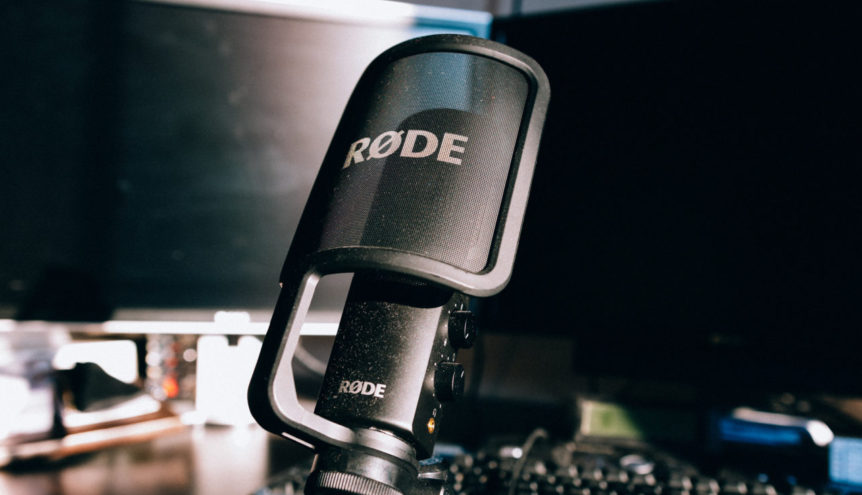
This is the review of the comparison between two microphones from two different brands. The comparison here is between the Blue Yeti Pro and the Rode NT-USB. There are day and night differences in their price range and also, there are differences in the features and performances. To know which one is good for you, go to the detailed review.
 |  |
| Blue Yeti Pro | Rode NT-USB |
| BUY NOW | BUY NOW |
| PROS | PROS |
| Very good sound quality. Can be used as a standalone microphone with a mixer or as a USB microphone. Versatile. Sturdily built. | Ease of use via USB connectivity. Good at filtering out background noise. Thoughtful design. |
| CONS | CONS |
| Can take a bit of setting up. Large and heavy so not very portable. Pricey for a USB mic. | Picks up table knocks and keystrokes. Only one polar pattern. |
SPECIFICATIONS:
| HEADER | BLUE YETI PRO | RODE NT-USB |
| Brand | Blue Microphones | Rode |
| Product Line | Blue Microphones Yeti | Rode NT-USB |
| Model | Pro | Rode NT-USB |
| GENERAL | BLUE YETI PRO | RODE NT-USB |
| Manufacturer | Logitech | Rode |
| Recommended Use | Professional audio – recording | |
| MICROPHONE | BLUE YETI PRO | RODE NT-USB |
| Microphone Technology | electret condenser | condenser |
| Microphone Operation Mode | bi-directional, cardioid, omni-directional, stereo | cardioid |
| Sensitivity | ||
| Microphone Power Source Voultage (DC) | ||
| Frequency Response | 20 Hz | 20 Hz-20kHz |
| Signal-To-Noise Ratio | 114 db | |
| Total Harmonic Distortion (THD) | 0.5% | |
| Max Sound Pressure | 120 db | 110 db |
| Audio Input Details | Cardioid – 20 – 20000 Hz | |
| Connectivity Technology | Wired | Wired |
| AUDIO SYSTEM | BLUE YETI PRO | RODE NT-USB |
| Type | Microphone | Microphone |
| Recommended Use | Professional audio | |
| Specific Applications | Recording | |
| Additional Functions | Amplifier | |
| Controls | Mute, volume | |
| DIMENSIONS & WEIGHT | BLUE YETI PRO | RODE NT-USB |
| Component | ||
| Width | 4.7 in | 2.4 in |
| Depth | 4.9 in | 2 in |
| Height | 11.6 in | 7.2 in |
| Weight | 19.4 oz | 1.1 lbs |
| FEATURES | BLUE YETI PRO | RODE NT-USB |
| Features | Three custom condenser capsules and four different polar pattern settings: Cardioid, Stereo, Bidirectional and Omnidirectional. Cutting-edge A-D converter chip and separate analog circuit path for use with professional studio mixers and preamps. Built-in headphone amplifier for zero-latency monitoring, and direct controls for headphone volume, pattern selection, mute, and microphone gain. 15Hz – 22KHz frequency response. 192KHz/24 bit Sample / Word. | ENSURE YOU BUY GENUINE RØDE: Products from sellers which say ‘fulfilled by Amazon’ under the price are NOT authorized resellers, and may not be selling genuine product. Buy only from Amazon.com (labelled ‘shipped and sold by Amazon.com’) High quality studio microphone with the convenience of USB connectivity. Pop shield, Tripod desk stand, ring mount, storage pouch and 6m (20’) USB cable included. 3.5mm stereo headphone jack for zero-latency monitoring. |
Detail Review:
INTRODUCTION:
Blue Yeti Pro
The Blue Yeti Pro is a professional USB microphone that anybody can use at home or in a professional setting, plugs in right via USB to a Mac or PC. This microphone is retailing for a higher price of three hundred and eighty dollars currently in Amazon. This microphone works with both USB and XLR which is really great.
Rode NT-USB
The Rode NT-USB is a USB microphone meaning it should work just by plugging it directly into your computer, it is listed as compatible with Mac, PC as well as iPad. If you are interested in this microphone it’ll set you back about a hundred and seventy dollars currently. This microphone uses only one polar pattern that is the cardioid pattern and it does its job great in that pattern.

DESIGN:
Blue Yeti Pro
The Blue Yeti Pro looks very stylish, I do like the look of it and it looks very nice on a desk. It does have some weight to it, it weighs about 1.2 pounds, it’s a good thing because it’s gonna be nice and sturdy and solid on your desk, its not gonna tip over anything like that. It also does have a little bit of height to it as well, so it’s gonna be sitting up a little bit higher on your desk which is actually a good thing, so it’ll be able to pick up the audio nice and clear just because it’s gonna be probably closer to your mouth. I do like the stature of the Blue Yeti Pro itself.
On the front, you’ll find a mute button which you can press in and you will see pressing it starts blinking that let you know no audio is being recorded, and right below that, you’ll find a master volume control. In the back of the Blue Yeti Pro, you’ll find the mic gain control, and also the four polar pattern selector. So, you can go between stereo, cardioid, omnidirectional, or bidirectional right there on the back of the microphone itself.
You can also flip the microphone all the way down, which is a good thing because this is gonna be really good for transportation. On the bottom, you’ll find a stereo XLR output, the microphone does come with the stereo XLR cables as well. Also, on the bottom, you’ll find a micro-USB port out, and also you’ll find a headphone jack.
Rode NT-USB
As far as the build quality, the microphone feels really nice, it is a full metal body, a metal grill, it has some really nice weight to it, and the knobs on the side don’t feel loose. On the side of the microphone, you have got two dials, the top one changes the amount of the sound source that you hear, so this does provide zero-latency monitoring. The bottom dial just controls the volume of your headphones, and then lastly you have a headphone port for zero-latency monitoring. Honestly, I think it’s pretty insane they put these dials on the side of the microphone and didn’t put a microphone gain control on it.
The pop shield is all metal, and it feels kind of flimsy, so you should be careful with that. The cable is just your standard USB cable nothing special there. The stand is plastic, and it doesn’t feel that great, and there is no shock absorption, so if you bump your table and you’re using this microphone stand, the microphone will pick it up. The pouch on the other hand does have some nice padding in it to protect the microphone.

FEATURES:
Blue Yeti Pro
The headphone jack in this microphone is a zero-latency headphone jack, so you can plug some headphones in there and monitor the audio that’s coming out of the microphone or actually going inside the microphone. Also, you can listen to the audio that’s coming out of your computer because that will be transported right between the microphone, so you can kind of listen to what you may have going on in your computer itself.
It looks good, it does have enough knobs and buttons on there, and features that I think would be a little bit handy to everybody else, especially that headphone jack feature I really like that part of it. This is a USB mic and one of the greatest things about the USB port on this microphone is rather than just plugging it into your computer, and selected as an input, it actually works as an output as well. So, it acts as a digital to analog converter which is amazing because if you’re monitoring your own microphone, you can also monitor the track that’s being played. So, this is great for recording, it’s excellent because you can seriously hear what’s being heard from the inside, that’s pretty darn cool.
Rode NT-USB
In the Box, you get the microphone, you get a pop shield, you get a 6-meter USB cable, you get the microphone stand, you get the microphone mount, you get a carrying pouch, some documentation as well as a two-year warranty, and an I love Rode microphone sticker. As far as the specifications, it has a cardioid polar pattern, the frequency response is 20 Hertz to 20 kilohertz, and it offers a 16-bit 48-kilohertz recording resolution.
This is a cardioid condenser microphone with a pressure gradient acoustic principle. The frequency is definitely somewhat flat for the most part but is gets boosted in the high ends as it is a carioid condenser microphone. As per my test I would not recommend you to use this as your desktop microphone because it picks up a lot of keyboard noise and many things.

PERFORMANCE:
Blue Yeti Pro
The Blue Yeti Pro definitely sounds better than the Samson C03U, make the sound a little bit richer, a little bit more clear than what you’ll find with the Samson microphone which isn’t a bad microphone itself but I think the Blue Yeti Pro tops it as far as just the overall audio quality. If you wanna be doing any type of podcast, any type of radio, as this has a very nice warm sound to it so, you can do that with this microphone. I think it sounds awesome, again it’s a nice warm sound, really great sound, and just with the audio quality, you are getting from this thing you can see a lot of advantages, a lot of applications you can do to it. It can be used for recording some music.
Rode NT-USB
Overall, I think it’s a decent sounding mic, the polar pattern did do pretty well at eliminating background noise like the keyboard, and also when I’m just speaking into the microphone I think it sounds pretty great. But for music, no matter what I set my input gain at, if the sound source was loud like I was singing loudly, or my guitar amp was turned up loud, or I was playing my acoustic really loud, it would sound like it was clipping, even though I had plenty of headroom on my input settings.

WHICH ONE IS FOR YOU?
You can go for any one microphone out of the above two microphones after considering the points below:
- I would recommend the Rode Nt-USB microphone pretty much only if you’re going to be doing voiceovers, or gaming, or something like that. If you’re going to be recording music I would not recommend this microphone it seems to be too sensitive to pick up any sort of loud instruments. Also, it’s pretty insane that they have dials on the side but neither of them controls the microphone’s gain, that’s a huge oversight.
2. I would recommend the Blue Yeti Pro, if you want a microphone which supports the USB and the XLR both. If you have the Blue Yeti already and there is no need for you to go for the Blue Yeti Pro.
Expert Reviews of Blue Yeti Pro:
By Trusted Reviews
The Blue Yeti Pro is definitely a bit pricey for hobbyists, but if you’re seriously into your home recording or your small media business is looking to get the best audio for its…By Musicrepo
For many, this is the ultimate USB microphone. It costs more, but its sheer versatility and high recording quality make it a good investment. My only criticism, really, is the size…By Engadget
Like all Blue products, the Yeti Pro is a looker. While attached to the included stand, it looms at almost a foot tall. Handsome textured black and silver metal encloses the…By Mixdown
Ideal for beginners and advanced users alike, the Yeti Pro Studio is a microphone that will continue to deliver results as your needs develop. Yes, it doesn’t lend itself to use with standard suspension mounts, so it…By thenextweb.com
The Yeti Pro is also capable of exponentially higher bitrate recordings than the original Yeti. You can crank that sample rate all the way up to 192 kHz, instead of 48 kHz like the original Yeti. If you’re not familiar…Expert Reviews of Rode NT-USB:
By music radar
Your computer’s perfect partner for recording vocals and acoustic instruments with minimal fuss.By PC Gamer
Overall, if you’re serious about voiceover (be it for streaming, podcasts, or something else) and fancy dabbling in music as well, this is the ideal microphone. Brilliant audio-quality trumps the competition in almost…By microphone geeks
Overall, this mic simply rocks… it is relatively cheap but it beats the crap out of the competitors’ models at any time. Rode NT-USB is unarguably the best microphone of choice for today. Once you’ll have…By camaralabs
The Rode NT USB is a high-quality USB microphone designed to capture broadcast-quality vocals or music with a simple USB connection to your computer or laptop; indeed, with the supplied pop shield, tabletop stand, and long cable, you’re ready to record high-quality audio wherever…By Sound On Sound
USB mics are becoming increasingly common and affordable, but the quality varies. The Rode brand name, though, is one that instils a certain level of confidence with regard both to the quality of the engineering and the quality of the…




